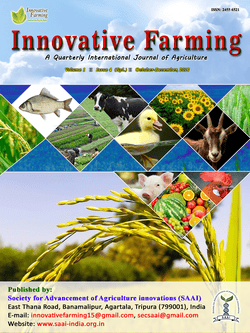
Allium Diseases: A Global Perspective
S. Parthasarathy*
Dept. of Plant Pathology, Centre for Plant Protection Studies, Tamil Nadu Agricultural University, Coimbatore - 641003, India
S. Rajamanickam
Dept. of Plant Pathology, Centre for Plant Protection Studies, Tamil Nadu Agricultural University, Coimbatore - 641003, India
M. Muthamilan
Dept. of Plant Pathology, Centre for Plant Protection Studies, Tamil Nadu Agricultural University, Coimbatore - 641003, India
DOI: NIL
Keywords: Allium, Diseases, Fungi, Garlic, Onion
Abstract
Allium crops were well known slightly perishable spicy vegetables. It is highly valued as anti drug, odor and flouring agents. The success of alliums global market is its inherent ability to be stored for long time. About 35-40% crop is lost due to damage caused by field and storage diseases. The fungal bulb rot imparts to about 15-30% losses during storage of different varieties. There are diverse fungal, oomycetes and bacterial pathogens like Alternaria porri, Aspergillus niger, Botrytis allii, Colletotrichum circinans, Dikeya chrysanthemi, Erwinia carotovora, Fuarium oxysporum, Peronospora destructor, Phytophthora nicotianae, Pythium spp., Rhizopus stolonifer and some viral agents which attacks alliums during the field and post-harvest storage period. Amongst all Alternaria porri is the most virulent fungal pathogen in the field. The preventive approach of using fungicides to reduce the disease incidence is insufficient to provide safe for human consumption and may be hazardous for the human health due to residual impact issues. Therefore, it is mandatory to develop novel integrated strategies to reduce the crop losses by the potent application of newer molecules, bioagents and adotation of sanitation, crop rotation or in the form of combinations.
Downloads
not found
Reference
Abawi, G.S. and J.W. Lorbeer. 1971. Pathological histology of four onion cultivars infected by Fusarium oxysporum f. sp. cepae. Phytopathology, 61: 1164–1169.
Abawi, G.S. and J.W. Lorbeer. 1972. Several aspects of the ecology and the pathology of Fusarium oxysporum f. sp. cepae. Phytopathology, 62: 870-876.
Aveling, T.A.S. 1998. Purple blotch (Alternaria porri) of onion. Recent Research and Development in Plant Pathology, 2: 63-76.
Brunt, A.A., K. Crabtree, M.J. Dallwitz, A.J. Gibbs, L. Watson and E.J. Zurcher. 1996. Plant Viruses Online: Descriptions and Lists from the VIDE Database. Version: 20th August. http://pvo.bio-mirror.cn/descr538.htm.
Chen, J., J. Chen and M.J. Adams. 2001. Molecular characterization of a complex mixture of viruses in garlic with mosaic symptoms in China. Achieves of Virology, 146: 1841–1853.
Clinton, G.P. 1915. Notes on plant diseases of Connecticult. Conn. Agr. EXP. Stat. Ann. Rpt., 6: 421-451.
Conci, V.C. and S.F. Nome. 1991. Virus free garlic (Allium sativum L.) plants obtained by thermotherapy and meristem tip culture. Journal of Phytopathology, 132: 186–192.
Coskuntuna, A. and N. Ozer. 2008. Biological control of onion basal rot disease using Trichoderma harzianum and induction of antifungal compounds in onion set following seed treatment. Crop Protection, 27: 330-336.
Cramer, C.S. 2000. Breeding and genetics of Fusarium basal rot resistance in onion. Euphytica, 115: 159-166.
Diekmann, M. 1997. FAO/IPGRI Technical guidelines for the safe movement of germplasm, No. 18. Allium spp. Food and Agriculture Organization of the United Nations, Rome/International Plant Genetic Resources Institute, Rome.
Entwistle, A.R. 1990, Allium white rot and its control, Soil Use and Management, 64: 201.
Gupta, R.B. and V.N. Pathak. 1988. Yield losses in onions due to purple leaf blotch disease caused by Alternaria porri. Phytophylactica, 20: 21-23.
Horst, R.K. 2013. Field Manual of Diseases on Fruits and Vegetables. Springer Dordrecht. pp. 115-123. ISBN 978-94-007-5974-9 (eBook), DOI 10.1007/978-94-007-5974-9.
Jennings, D.M., B.V. Ford-Lloyd and G.M. Butler. 1990. Rust infections of some Allium species: an assessment of germplasm for utilizable rust resistance. Euphytica, 49: 99-109.
Kamenetsky, R. and R.M. Fritsch. 2002. 19 Ornamental Alliums. Pp. 459–491 in Allium Crop Science: Recent Advances, (Eds.) Rabinowitch, H.D. and L. Currah. CABI Publishing, Wallingford, pp. 529.
Koike, S.T., J.D. Barak, D.M. Henderson and R.L. Gilberston. 1999. Bacterial Blight of Leek: A new disease in California caused by Pseudomonas syringae. Plant Disease, 83(2): 165-170.
Koike, S.T., P. Gladders and A.O. Paulus. 2007. Vegetable Diseases – A Colour Handbook. Manson Publishing Ltd, London. pp. 232-256. ISBN-13: 978-1-84076-075-0.
Lelliott, R.A. 1952. A new bacterial disease of leeks. Plant Pathology. 1: 84-85.
Lot, H., V. Chovelon, S. Souche and B. Delecole. 1998. Effects of onion yellow dwarf and leek yellow stripe viruses on symptomatology and yield from three French garlic cultivars. Plant Disease, 82: 1381–1385.
Samson, R., H. Shafik, A. Benjama and L. Gardan. 1998. Description of the bacterium causing blight of leek as Pseudomonas syringae pv. porri (pv. nov.). Phytopathology, 88(8): 844–850.
Schwartz, H.F. and S.K. Mohan. 2004. Compendium of Onion and Garlic Diseases, APS Press, St. Paul, MN, USA, pp. 10-11.
Shahanaz, E., V.K. Razdan and P.K. Raina. 2007. Survival, dispersal and management of foliar blight pathogen of onion. Journal of Mycology and Plant Pathology, 37(2): 213 - 214.
Sharma, P. 2007. Vegetables: Disease Diagnosis and Biomanagement. Aavishkar Publishers, Jaipur, India. ISBN 978-81-7910-196-4.
Shiboleth, Y.M., A. Gal-On, M. Koch, H.D. Rabinowitch and R. Salomon. 2001. Molecular characterization of Onion yellow dwarf virus (OYDV) infecting garlic (Allium sativum L.) in Israel: Thermotherapy inhibits virus elimination by meristem tip culture. Annals of Applied Biology, 138: 187–195.
Walker, J.C. 1921. Onion smudge. Journal of Agricultural Research, 20: 685-722.
